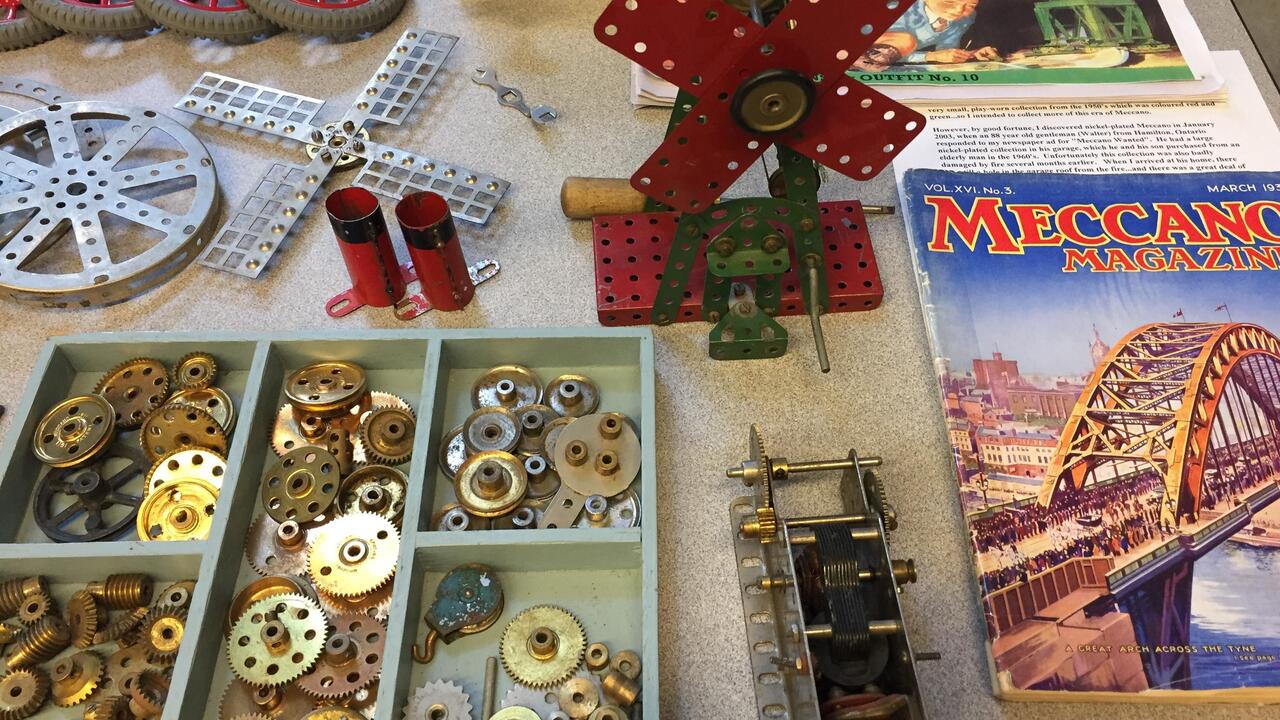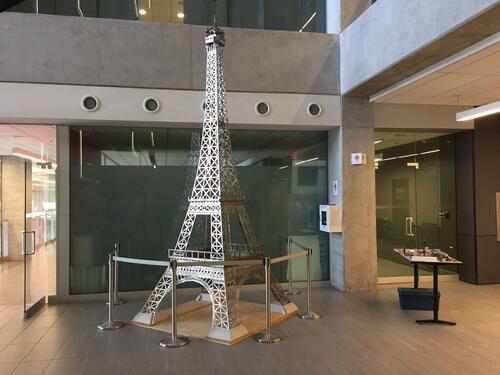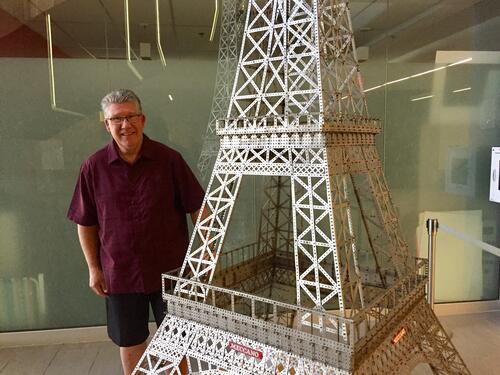
Scaling the Eiffel Tower with Meccano
Alumnus builds iconic structure using 100-year-old pieces of the toy of his youth

Alumnus builds iconic structure using 100-year-old pieces of the toy of his youth
By Carol Truemner Faculty of EngineeringArt Stokman jokes that instead of buying an expensive sports car when he turned 50, he marked the milestone birthday by taking up his childhood hobby.
The 1974 electrical engineering graduate decided to add to his small play-worn collection of red and green Meccano, a popular kids’ building toy of the early to mid-20th century. Hundreds of hours and over 10,600 pieces later, he completed a model of the iconic Eiffel Tower. Stokman’s labour of love currently stands tall in the main foyer of Waterloo Engineering’s E5.
"Meccano was the toy of my youth. It was my inspiration to go into engineering," says Stokman. "When you think of STEM (science, technology, engineering and mathematics) learning, there hasn’t been a better toy that introduced anyone into those areas."
One of a family of nine children who grew up on a dairy farm in the Guelph and Rockwood, ON area, Stokman played with his set of Meccano until he finished grade school.

Art Stokman's Meccano Eiffel Tower in E5.
In 2000, he began his quest for more pieces of the toy that consisted of metal strips, plates, angle girders, wheels, axles, gears, motors, nuts and screws. His renewed interest took him to numerous garage sales and antique shops throughout Ontario, the United States and to other countries by way of eBay.
One of his best finds came in 2003 after he placed a “Meccano Wanted” ad in a newspaper. Walter, an 88-year-old living in Hamilton at the time, let Stokman know about his large nickel-plated collection, which he and his son purchased from an elderly man in the early 1960s.
“Unfortunately, his son had passed away and Walter wanted his Meccano to go to someone who could restore and reuse some of the pieces of his collection that had been badly damaged by fire several months earlier,” Stokman recalls. “I purchased his collection and told him I would build something special with it someday.”
That something special is the Eiffel Tower that Stokman planned and built from photos and information he found on the Internet. Once he began the project, Stokman discovered that he would need much more Meccano of the same era to complete his tower.
It took him an entire year over a 13-year period to collect and clean all the 100-year-old nickel-plated pieces by hand, and to plan and build the tower. He ended up discarding about a quarter of the parts that were too rusted to be used.
Stokman, who worked in the electrical distribution industry in southwestern Ontario for 28 years, retired as President of Guelph Hydro in 2009. Prior to that, he worked as a project engineer on major contracts including oil refineries and power generation plants. With more spare time on his hands after retirement, he was able to concentrate on completing his Meccano masterpiece.
Since beginning construction in his garage, Stokman and his wife Johanna have moved four times and the Eiffel Tower came along with them.
In September 2016, Stokman put the finishing touches on the 14 foot 2 inch structure built to 1/75th scale – 1 inch of Stokman’s model = 6 feet 3 inches of the real one in Paris, France.
"I tried to build the tower to the best detail that Meccano parts could provide," he explains. "The actual Eiffel Tower is only 28 years older than the average age of the structural parts used to build the model."
Last fall and winter, Stokman’s Eiffel Tower was featured in the atrium of Cambridge city hall after the director of economic development for Cambridge saw it when it was nearly completed. He thought it would be a great icebreaker for customers and visitors to city hall because it would stimulate conversation regarding architecture, engineering and travel. There are plans to move the tower back later this year to Cambridge – this time to the Cambridge Idea Exchange at the public library.
There has been a resurgence in Meccano since Spin Master bought the rights to it four years ago. The Canadian company has reinvented the toy, incorporating current technology while focusing on STEM learning and innovation.
Spin Master will be sharing its toy-making expertise with Waterloo Engineering students later this fall.
For the first time, 1A mechanical engineering students enrolled in ME 100 have been given the challenge of designing a toy. Through a partnership between Spin Master and Waterloo’s mechanical and mechatronics engineering department, MME Clinic and Engineering IDEAs Clinic, students are developing designs for different age ranges and play patterns. They will receive professional critiques on their prototypes from Spin Master engineers before presenting them to faculty members at the end of the fall term.
Stokman is pleased to hear about the Spin Master connection at Waterloo Engineering and how the design project is helping build new skills. As member of a Canadian Meccano club, he and a group of dedicated hobbyists travel to toy shows a few times each year to help inspire young minds.
“Meccano gets kids to step away from the computer and build with their hands,” Stokman says. “By using their imaginations, they can construct anything.”

Tower builder, Art Stokman.

Read more
Here are the people and events behind some of this year’s most compelling Waterloo stories

Read more
A winter holiday message from President Vivek Goel

Read more
The Waterloo community comes together to remember, reflect and respond to gender-based violence
The University of Waterloo acknowledges that much of our work takes place on the traditional territory of the Neutral, Anishinaabeg, and Haudenosaunee peoples. Our main campus is situated on the Haldimand Tract, the land granted to the Six Nations that includes six miles on each side of the Grand River. Our active work toward reconciliation takes place across our campuses through research, learning, teaching, and community building, and is co-ordinated within the Office of Indigenous Relations.